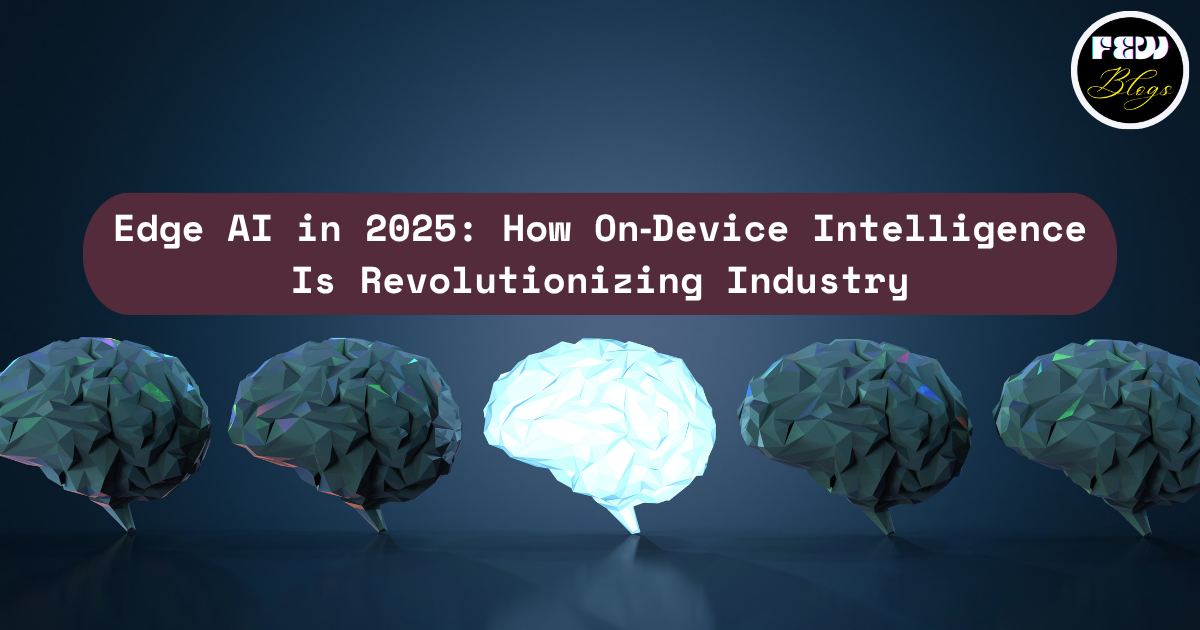On-Device Intelligence: Key Edge AI Trends for 2025
Discover how On-Device Intelligence powers real-time analytics, predictive maintenance, and privacy-first computing at the edge. Read more on FewBlogs.com..
ARTIFICIAL INTELLIGENCE (AI)
Pravash Pujari
7/30/20254 min read


Introduction
As artificial intelligence (AI) matures, processing power is shifting from centralized cloud platforms to the very devices at the edge of networks. Edge AI—running machine‑learning models directly on sensors, cameras, smartphones, or specialized hardware—combines the power of advanced analytics with low latency, enhanced privacy, and reduced bandwidth requirements. In 2025, Edge AI is no longer a niche experiment; it’s becoming mission‑critical in manufacturing floors, healthcare facilities, autonomous vehicles, retail outlets, and smart cities.
This deep‑dive explores the key drivers of Edge AI’s rapid adoption, examines its most compelling industry use cases, outlines how to build robust on‑device intelligence pipelines, addresses the technical and organizational hurdles, and forecasts where Edge AI will head beyond 2025.
1. Driving Factors & Market Trends
1.1 Growing Hardware Ecosystem
Specialized AI Chips: Companies such as NVIDIA (Jetson series), Intel (Movidius Myriad X), Google (Edge TPU), and Qualcomm (Snapdragon with AI accelerators) are shipping low‑power inference accelerators optimized for convolutional neural networks and transformer architectures.
TinyML Frameworks: Open‑source toolkits like TensorFlow Lite, PyTorch Mobile, and Arm’s CMSIS‑NN simplify training and deploying compact models on microcontrollers with just kilobytes of RAM.
1.2 Infrastructure Enablers
5G & Beyond: Ultra‑reliable, low‑latency wireless connectivity allows edge devices to synchronize with the cloud when needed, offload heavy compute, and coordinate in real time.
Containerization & Orchestration: Lightweight runtimes (e.g., NVIDIA Fleet Command, AWS IoT Greengrass) facilitate scalable deployment, versioning, and over‑the‑air updates of edge‑optimized containers.
1.3 Market Projections
CAGR Growth: Analysts forecast the Edge AI hardware and software market to expand at a compound annual growth rate (CAGR) of over 35% between 2022 and 2026, reaching a value north of USD 40 billion by 2026.
Enterprise Adoption: By 2025, an estimated 75% of enterprise AI inferencing will occur at the edge rather than in the cloud, driven by security, compliance, and operational efficiency considerations.
2. Top 5 Industry Use Cases
2.1 Smart Manufacturing
Predictive Maintenance & Quality Control
Anomaly Detection: On‑machine sensors equipped with vibration or acoustic analysis models identify deviations from normal operating signatures, enabling proactive maintenance and reducing downtime.
Visual Inspection: Edge‑mounted cameras powered by computer vision algorithms catch defects on production lines—missing components, surface blemishes, or misalignments—at sub‑second speeds.
2.2 Healthcare & Wearables
Real‑Time Patient Monitoring
Vital Signs Analytics: Wearable ECG patches and smartwatches running arrhythmia‑detection models can alert medical staff immediately upon detecting cardiac anomalies, even without continuous cloud connectivity.
Privacy‑First Diagnostics: Sensitive health data (e.g., glucose levels, oxygen saturation) is processed and encrypted at the device, ensuring compliance with HIPAA and GDPR without transmitting raw data.
2.3 Autonomous Vehicles & Drones
Low‑Latency Perception & Safety
Object Detection & Tracking: Onboard cameras and LiDAR units interpret dynamic traffic scenes, recognizing pedestrians, other vehicles, and obstacles in real time, unhindered by network latency.
Collision Avoidance: Edge AI systems execute emergency braking or evasive maneuvers within milliseconds of hazard detection, a requirement no cloud hop can satisfy.
2.4 Retail & IoT
In‑Store Personalization & Analytics
Footfall & Behavior Analysis: Edge‑deployed computer vision models count customers, analyze dwell times, and map movement patterns—all without sending video streams to the cloud.
Dynamic Digital Signage: Smart displays adjust promotions based on real‑time demographics inferred on device (e.g., age group, gender, sentiment), increasing engagement and conversion rates.
2.5 Smart Cities
Traffic Management & Public Safety
Edge‑Driven Traffic Signals: Integrating vehicle‑density detection on street‑corner cameras empowers adaptive signalling algorithms that reduce congestion and emissions.
Security & Compliance: City‑wide surveillance networks leverage on‑device face and license‑plate recognition for law enforcement, while minimizing privacy exposure by only transmitting alerts and metadata.
3. Building an Edge AI Pipeline
Deploying robust Edge AI solutions requires thoughtful architecture and tooling at each stage of the data‑to‑insight journey.
3.1 Data Collection & Preprocessing
Signal Conditioning: Sensors often produce noisy analogue readings. Implement digital filtering (e.g., Kalman, Butterworth) on the device to stabilize the input.
Data Augmentation: Augment on‑device training with techniques like rotation, cropping, or noise injection to improve model robustness without additional cloud resources.
3.2 Model Optimization
Quantization: Reduce model weights from 32‑bit floating point to 8‑ or even 4‑bit integer precision without significant accuracy loss, slashing memory footprint and inference latency.
Pruning & Knowledge Distillation: Remove redundant neurons or transfer knowledge from a large “teacher” model to a smaller “student” network, yielding lightweight on‑device architectures.
3.3 Deployment & Management
Containerization: Package optimized models, runtimes, and dependencies into edge‑ready containers (e.g., Docker, Balena).
Over‑the‑Air (OTA) Updates: Use secure protocols (MQTT over TLS) to push model updates or configuration changes, ensuring field devices always run the latest software.
3.4 Monitoring & Feedback
On‑Device Telemetry: Collect inference metrics (latency, confidence scores, error rates) and periodic health checks for proactive troubleshooting.
Edge‑to‑Cloud Sync: Transmit summarized insights or anomaly logs to central dashboards for enterprise‑wide visibility and continuous model retraining.
4. Challenges & Mitigation Strategies
4.1 Resource Constraints
Compute & Memory Limits: Edge devices range from microcontrollers (tens of KB RAM) to embedded GPUs. Select models and runtimes that match target hardware capabilities.
Energy Efficiency: Battery‑powered devices demand ultra‑low power consumption. Leverage hardware accelerators (DSPs, NPUs) and aggressive power‑management policies.
4.2 Security & Privacy
Firmware Integrity: Secure boot and signed firmware ensure only authenticated code runs on devices.
Data Privacy: Encrypt data at rest (on flash memory) and in transit (TLS), and implement GDPR‑compliant data‑minimization practices.
4.3 Edge‑Cloud Orchestration
Consistency & Versioning: Maintain synchronization between edge models and cloud‑based training pipelines. Implement semantic versioning and rollback capabilities for safe deployments.
Network Variability: Design for intermittent connectivity—queue inference results locally and batch‑sync when bandwidth is available.
5. Future Outlook Beyond 2025
5.1 Federated & Collaborative Learning
Edge devices will jointly train models by sharing encrypted gradients rather than raw data, improving personalization while preserving privacy.
5.2 Neuromorphic & Spiking Neural Networks
Emerging hardware mimics biological neurons, offering orders‑of‑magnitude improvements in energy efficiency for on‑device AI.
5.3 Standards & Regulation
Expect frameworks for certifying Edge AI systems in safety‑critical domains (automotive, healthcare), akin to ISO 26262 or FDA 510(k).
6. Conclusion
Edge AI represents a paradigm shift: intelligence moves from distant clouds to the devices that generate and consume data. By 2025, on‑device AI will underpin critical applications across manufacturing, healthcare, mobility, retail, and smart cities—driven by specialized hardware, robust toolchains, and a pressing need for low‑latency, secure, and private analytics.
Organizations that embrace Edge AI today will unlock operational efficiencies, deliver richer user experiences, and gain a competitive edge. Whether you’re architecting predictive‑maintenance solutions, deploying autonomous drones, or delivering personalized retail experiences, the time to invest in Edge AI is now.
Further Reading & Resources
TensorFlow Lite: https://www.tensorflow.org/lite
